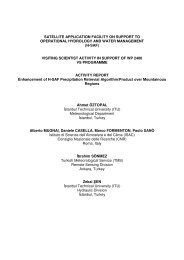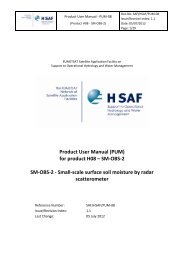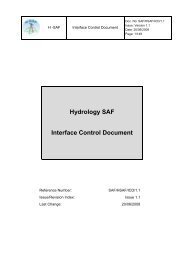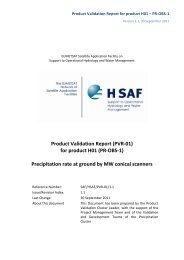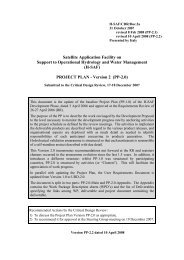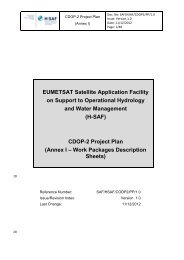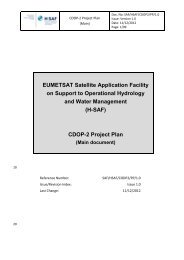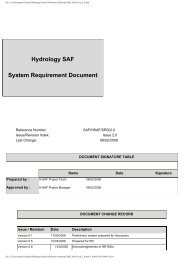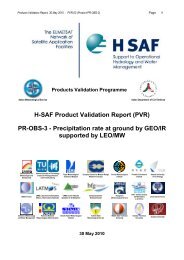Zuhal Akyurek, A. Unal Sorman - H-SAF
Zuhal Akyurek, A. Unal Sorman - H-SAF
Zuhal Akyurek, A. Unal Sorman - H-SAF
Create successful ePaper yourself
Turn your PDF publications into a flip-book with our unique Google optimized e-Paper software.
Chapter 5<br />
Conclusions and Recommendations<br />
5.1. Conclusions<br />
The VS activity showed the utility of the blended-snow product in mapping snow covered area<br />
and in snowmelt modeling. We examine the ability of the preliminary ANSA blended-snow<br />
product to improve the mapping of snow-covered area on mountainous terrain relative to using<br />
either MODIS or AMSR-E products alone. The utility of the blended snow products in deriving<br />
snow cover depletion curves to be used in the snow modeling is also analyzed. Results<br />
demonstrate a strong improvement of snow-cover extent mapping as compared to using either<br />
optical data (e.g. MODIS) or microwave data (e.g. AMSR-E) alone. The strength of optical data<br />
in determining the fresh snow on the ground is observed. The contribution from microwave data<br />
during the cloud cover days is also seen. The results support the need of developing snow cover<br />
products based on multi-sensor data sources to provide continuous regional and global snow<br />
cover mapping for climate, hydrological and weather applications.<br />
The accuracy of the blended snow cover products, namely ANSA, under development and<br />
verification by NASA-GSFC were tested for the first time in Turkey for the mountainous part of<br />
the country. Both 25 km and 5km resolution products were used during the accumulation and<br />
melting seasons of 2008. Not only for snow cover mapping the products were used in obtaining<br />
the snow cover depletion curves, which are the input parameters in snowmelt modeling. The<br />
snow cover area depletion curves were obtained from<br />
i. MODIS (daily(MOD10A1) and 8 day (MOD10A2)) products with and without<br />
including the percentages of cloud coverages of the respective day<br />
ii.With ANSA blended snow covered products with and without modification.<br />
One of the weaknesses of the ANSA blended snow product is the course resolution based on the<br />
SWE product resolution. The course resolution problem leading the mix-pixel problem can be<br />
more important for hydrological studies on a regional basis. The main objective of the ANSA<br />
blended snow product is to map snow on the ground on a global basis. Therefore the snow/nosnow<br />
thresholds are set at minimum levels. In using the ANSA snow product in hydrological<br />
implementations the SWE thresholds were modified. In this preliminary modification, the<br />
limitation of the AMSR-E in retrieving shallow SWE is considered and 5cm snow depth<br />
threshold is used in the modified ANSA snow product. This modification helps to obtain more<br />
reasonable SCA depletion curves compared to SCA depletion curves obtained from MOD10A1<br />
products. However the abrupt changes in the SCA depletion curves, which are not, recommended<br />
in the manual of snow melting model (SRM), lead overestimation in the runoff predictions.<br />
Considering 30% cloud cover in the snow classification from MODIS daily snow products<br />
produce comparatively reasonable runoff predictions in the preliminary modeling analysis. One<br />
another weakness of the ANSA blended snow cover product is the limitations of AMSR-E<br />
instrument in wet snow retrieval. This limitation affects the correctness of SCA depletion curves<br />
for the melting period.<br />
35




